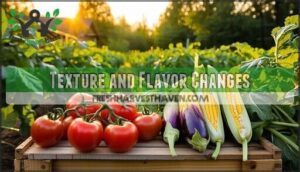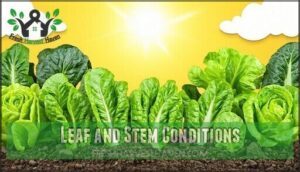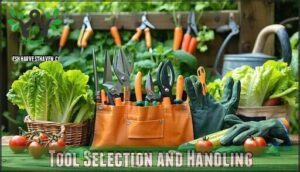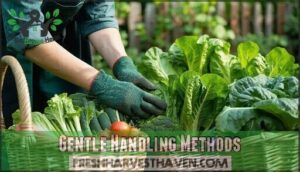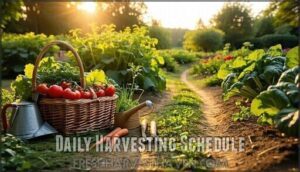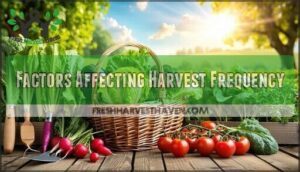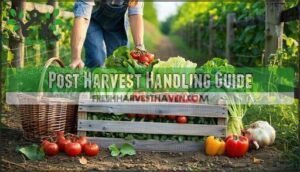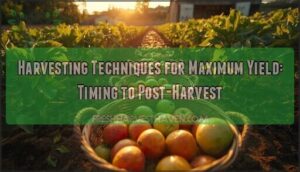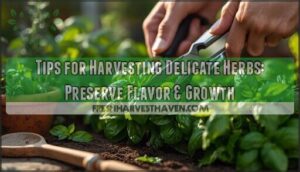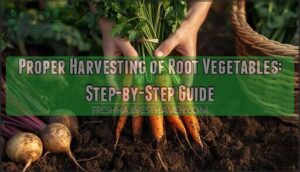This site is supported by our readers. We may earn a commission, at no cost to you, if you purchase through links.
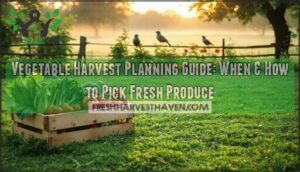
Morning harvests typically yield better flavor and longer storage life. Different vegetables demand specific techniques – tomatoes need gentle twisting, while root crops require careful digging.
Weather conditions directly affect harvest schedules, with dry mornings being ideal for most crops. Regular inspection prevents overripe produce and helps maintain continuous yields throughout the growing season.
Proper post-harvest handling maintains quality and extends shelf life substantially. The secret lies in recognizing those subtle clues that separate good gardeners from great ones, and understanding the importance of timing signals, peak ripeness, and proper post-harvest handling to achieve a successful harvest.
Table Of Contents
Key Takeaways
- You’ll maximize flavor and nutrition by harvesting in the morning when vegetables contain peak sugar content and moisture levels, typically between 6-10 AM, before heat degrades quality.
- Watch for specific ripeness signals, like color changes, proper sizing, and texture shifts, to determine ideal harvest timing rather than relying solely on seed packet dates.
- Use proper tools and gentle handling techniques, including sharp pruners, shallow baskets, and supporting heavy fruits from underneath, to prevent damage and maintain quality.
- Establish a daily monitoring routine, checking fast-growing crops, like lettuce and beans, daily, while slower vegetables need weekly assessments to prevent overripening and maximize yields.
Harvest Timing Factors
Several key factors determine when your vegetables reach peak harvest readiness, and understanding these variables helps you maximize both flavor and yield.
Your local climate conditions, soil quality, and specific vegetable varieties all influence timing, making it essential to monitor these elements rather than relying solely on seed packet dates, to ensure you get the best yield.
Vegetable Type Variations
Different vegetable types follow distinct harvest cycles that you’ll need to master.
Leafy greens like lettuce mature in 30-45 days, while root crops such as carrots need 60-90 days.
Fruit varieties including tomatoes require 70-90 days to ripen, and understanding these vegetable classification differences helps you plan your harvest timing effectively across seasons.
Climate and Weather Effects
Weather patterns substantially influence your harvest timing decisions across different climate zones.
Temperature fluctuations above 32°C reduce cool-season crop yields by 40%, while frost damage can destroy 10-60% of emerging plants.
Smart temperature management prevents devastating crop losses that can wipe out entire harvests.
Consider these weather impact factors for harvest planning:
- Temperature Fluctuations – Monitor nighttime temperatures below 10°C that inhibit fruit set in tomatoes and peppers
- Rainfall Impact – Excessive moisture increases fungal disease risk by 20-80%, while drought reduces cucumber yields by 50%
- Seasonal Harvesting – Adjust planting dates 7-14 days based on seasonal forecasts for ideal market timing
Soil Quality Impact
Rich soil accelerates vegetable development while poor conditions delay harvest timing.
Soil testing reveals nutrient levels and pH balance that directly affect crop maturity rates.
Well-amended soil with adequate organic matter produces faster-growing vegetables, while deficient soil requires fertilizer effects to reach desirable harvest windows.
Proper soil preparation guarantees consistent harvest schedules, ensuring that crop maturity rates are optimized.
Vegetable Maturity Signs
You’ll recognize mature vegetables by watching for specific visual cues like proper color development, appropriate size ranges, and surface texture changes that signal peak ripeness.
These physical indicators, combined with changes in leaf appearance and stem condition, provide reliable signals for ideal harvest timing across different vegetable types, which is crucial for identifying peak ripeness.
Color and Size Indicators
Visual cues provide the most reliable harvest timing indicators for home gardeners.
You’ll recognize ideal harvest times by observing specific fruit color and vegetable size benchmarks that signal peak ripeness and nutritional content.
- Tomatoes reach maximum flavor at full red color, avoiding green shoulders that indicate incomplete ripening
- Bell peppers show peak vitamin C content when they’ve achieved their target color progression from green to red, yellow, or orange
- Broccoli heads are ready at deep blue-green color before tiny flower buds begin yellowing
- Zucchini offers best texture at 6-8 inches long before becoming seedy and tough
Texture and Flavor Changes
Beyond color and size, texture changes reveal critical ripening stages that directly impact flavor profiles.
You’ll notice firmness shifts as cell structure breaks down during the ripening process.
Touch tomatoes for slight give, press eggplant skin for spring-back response.
Sugar content increases affect texture – corn kernels become plump and milky when punctured.
These texture changes signal ideal harvest timing for peak vegetable flavors and quality.
Leaf and Stem Conditions
Healthy stems stand upright and firm, while weakened stems signal declining vegetable ripeness.
Watch for leaf wilting in leafy greens like chard—it indicates stress or overmaturity. Yellowing foliage quality suggests harvest time for many leafy vegetables.
Strong stem health supports proper nutrient flow, maintaining vibrant leaf color. For herb pruning, select stems with fresh, unwilted leaves for superior flavor and nutritional value.
Harvesting Techniques Tips
Proper harvesting technique protects both your plants and your produce quality.
You’ll need the right tools and gentle handling methods to maximize your garden’s productivity while preventing damage that leads to disease and reduced yields, which is crucial for maintaining high quality.
Tool Selection and Handling
Once you know what’s ready to harvest, you’ll need the right harvesting tools for the job.
Sharp tools like bypass pruners and harvest shears make clean cuts that heal quickly and prevent disease. Choose ergonomic tools with comfortable grips to reduce hand fatigue during long harvest sessions.
Garden shears work well for leafy greens, while pruning knives handle tougher stems. Always wear gardening gloves for protection and better grip control.
Having the proper gardening tools is essential for efficient harvesting and crop maintenance.
Gentle Handling Methods
Using the right tools means nothing if you don’t handle crops with care.
Rough handling damages delicate produce and reduces quality. Your approach matters as much as your equipment choice.
- Support heavy fruits like tomatoes and eggplants from underneath while cutting stems
- Twist and pull gently for leafy greens instead of yanking straight up
- Use shallow baskets to prevent crushing bottom layers during collection
- Handle root vegetables by their tops to avoid bruising the edible portions
Sanitizing and Cleaning Tools
Clean tools prevent disease spread between plants.
Wipe pruning tools and knives with rubbing alcohol or bleach solution after each use.
Disinfectant use requires 70% isopropyl alcohol for effective sterilization techniques.
Equipment maintenance includes washing gentle tools with soap and water, then air-drying completely.
Tool sanitization becomes second nature with practice.
Proper harvesting techniques involve understanding optimum harvesting to guarantee the best results with effective sterilization.
Daily Harvesting Schedule
You’ll maximize your harvest quality and productivity by establishing a consistent daily monitoring routine.
Early morning inspections allow you to identify ripe vegetables at their peak flavor and nutritional content while preventing overripe produce from reducing plant productivity.
Morning Harvest Benefits
Morning harvest delivers peak flavor preservation and ideal freshness factors.
You’ll capture vegetables at their nutritional prime when morning dew evaporates, concentrating sugars and essential compounds.
Harvest timing between 6-10 AM maximizes crop yield quality, as cool temperatures maintain cellular integrity.
Your harvest planning benefits from this natural window when vegetables retain maximum moisture and flavor compounds before heat degrades them.
Understanding the importance of daily harvesting techniques can also enhance the overall quality of your harvest with daily techniques.
Regular Inspection Importance
Daily scouting transforms your garden from guesswork into precise harvest planning.
Check each plant systematically for ripeness indicators, pest damage, and disease symptoms.
Crop monitoring reveals subtle changes that signal ideal harvest timing.
Regular garden checks prevent overripe produce from spoiling your entire yield.
Plant observation becomes second nature, ensuring you’ll never miss that perfect picking window again, and with daily scouting, you can enjoy the fruits of your labor, making precise harvest planning a reality.
Crop Monitoring Frequency
Effective crop checks require strategic timing based on your harvest schedules and growth tracking needs.
You’ll monitor fast-growing crops like lettuce daily, while slower vegetables need weekly field observations.
This harvest planning approach optimizes yield monitoring and prevents overripening.
- Daily monitoring: Check beans, zucchini, and tomatoes for ideal harvest timing tips
- Weekly assessments: Monitor root vegetables and brassicas through systematic growth tracking
- Bi-weekly reviews: Evaluate long-season crops like winter squash using harvest optimization strategies
Factors Affecting Harvest Frequency
Your harvest schedule depends on three key factors that determine how often you’ll need to check your garden.
Fast-growing crops like lettuce and radishes require daily attention, while slower vegetables like tomatoes and peppers need monitoring every few days based on weather conditions and variety characteristics.
Crop Type and Variety
Different vegetable varieties require varying harvest frequencies based on their classification and growth characteristics.
Fast-producing crops like zucchini and snap beans need daily picking during peak season, while root vegetables like carrots offer more flexible timing.
Your variety choices directly impact harvest planning – bush beans yield concentrated harvests versus pole varieties’ extended production.
Select varieties matched to your preferred harvest schedule and available time.
Understanding harvesting techniques is essential for maximizing yields and crop quality.
Growth Rate and Maturity
Understanding growth patterns from seed germination through plant development helps you master harvest timing. Each vegetable follows distinct maturation stages, with maturity signs appearing at predictable intervals.
Proper vegetable harvest planning requires tracking these growth patterns:
- Monitor days to maturity from seed packet dates
- Observe color changes indicating ripening stages
- Check size specifications for ideal harvest timing
- Test texture firmness as maturity approaches
- Track leaf condition changes signaling readiness
Vegetable ripening stages vary substantially between crop types, making maturity dates critical reference points for successful harvests, and understanding these patterns is key to achieving optimal plant development.
Weather and Climate Conditions
Weather patterns directly impact your harvest schedule through temperature extremes and seasonal variations.
Hot weather accelerates ripening in tomatoes and peppers, while cool temperatures slow growth rates.
Monitor weather forecasting to adjust picking frequency accordingly.
| Weather Condition | Harvest Impact | Adaptation Strategy |
|---|---|---|
| Temperature Extremes | Accelerated/delayed ripening | Adjust picking schedule |
| High Humidity | Increased disease risk | Harvest when dry |
| Frost Timing | Crop damage potential | Complete harvest early |
Climate zones determine your seasonal harvest windows.
Soil moisture levels affect vegetable quality and storage life.
Temperature control through shade cloth or row covers extends harvest periods during extreme weather events.
Post Harvest Handling Guide
Your harvest doesn’t end when vegetables leave the plant—proper post-harvest handling determines how long your produce stays fresh and flavorful.
Quick cooling, gentle handling, and appropriate storage methods can extend shelf life by days or even weeks.
Cooling and Storage Methods
Once you’ve picked your vegetables, proper cooling becomes your best friend for maintaining freshness and quality.
Temperature control starts immediately after harvest to preserve nutrients and extend shelf life.
Here are four essential cooling and storage methods:
- Forced-air cooling – Reduces vegetable temperature by 10-15°C within 1-2 hours using refrigeration techniques and controlled airflow systems
- Hydro-cooling – Effectively lowers field heat in crops like broccoli and sweet corn within 30 minutes using cold water baths
- Vacuum cooling – Ideal for leafy greens, removing 90% of field heat in less than 30 minutes through pressure reduction
- Crushed ice cooling – Commonly used for asparagus, carrots, and celery, maintaining prime cold storage temperatures and humidity control
Understanding air cooling systems is vital for effective post-harvest handling.
These harvest preservation methods guarantee your vegetables retain peak quality from garden to table.
Handling and Packing Techniques
After harvesting, proper containers prevent bruising and maintain quality.
Use breathable baskets for root vegetables, shallow trays for leafy greens, and ventilated boxes for fruits.
Handle produce gently during transport to avoid damage.
For ideal storage, consider using containers with breathable storage to preserve freshness.
| Container Type | Best For | Key Features |
|---|---|---|
| Perforated plastic crates | Root vegetables, firm produce | Stackable, washable, drainage holes |
| Shallow wooden flats | Leafy greens, herbs | Breathable, prevents crushing |
| Ventilated cardboard boxes | Tomatoes, peppers | Lightweight, disposable, air circulation |
| Mesh bags | Onions, garlic | Excellent airflow, easy handling |
| Padded containers | Delicate fruits | Cushioned protection, prevents bruising |
Preserving Freshness and Quality
Once you’ve properly handled and packed your harvest, preserving freshness and quality becomes your next priority.
Temperature control, humidity management, and proper storage containers will maximize your crop’s shelf life.
These harvest preservation techniques guarantee your hard work translates into lasting nutrition and flavor.
Understanding fruit preservation methods is vital for maintaining the quality of your produce.
Essential Freshness Tips for Peak Quality Control:
- Cool vegetables immediately – Drop temperatures to 32-40°F within hours to slow cellular breakdown and maintain crisp textures
- Monitor humidity levels – Store root vegetables at 90-95% humidity while keeping leafy greens at 95-100% for ideal freshness
- Separate ethylene producers – Keep tomatoes and peppers away from leafy greens to prevent premature aging and wilting
- Use breathable containers – Perforated bags and ventilated bins prevent moisture buildup while maintaining proper air circulation
Frequently Asked Questions (FAQs)
Can you succession plant for continuous harvests?
Yes, you can succession plant many vegetables by sowing seeds every 2-3 weeks throughout the growing season.
This technique works best with quick-maturing crops like lettuce, radishes, and beans for steady harvests.
How to prevent pests during harvest time?
Ninety percent of garden pests thrive during harvest season. You’ll protect your crops by harvesting promptly, using row covers, and removing overripe produce that attracts insects.
What companion plants help with harvesting?
Quick-growing companions like lettuce and radishes mature between slow-growing crops, maximizing space efficiency.
Fast-growing plants also provide living mulch, reducing weeds and retaining moisture around your main vegetables.
By using a companion planting guide, gardeners can optimize their harvest and create a balanced ecosystem, which is key to successful companion planting.
Should you fertilize before final harvest?
Stop fertilizing 2-3 weeks before your final harvest. Late-season fertilizer can delay ripening, reduce flavor concentration, and increase nitrate levels in leafy greens, compromising both taste and food safety.
How long can vegetables stay unharvested?
Most vegetables stay fresh in the garden for 3-7 days past peak ripeness. You’ll lose flavor and texture as time passes, so harvest promptly for best quality.
Conclusion
Like a well-tuned orchestra, your vegetable harvest planning guide harmonizes timing, technique, and care to create garden success.
You’ve learned to read nature’s signals, from color changes to texture shifts, ensuring you’ll pick produce at peak quality.
Morning harvests provide superior flavor and storage life, while proper handling techniques preserve freshness.
Weather awareness keeps you aligned with ideal conditions, and regular monitoring prevents waste and maintains continuous yields.
Your vegetable harvest planning guide transforms gardening from guesswork into precision, delivering fresh, flavorful produce throughout the growing season, ensuring peak quality and superior flavor.
- https://www.johnnyseeds.com/growers-library/methods-tools-supplies/market-gardening/succession-planting-interval-chart-vegetables.html
- https://extension.umd.edu/resource/vegetable-planting-calendar
- https://attra.ncat.org/publication/scheduling-vegetable-plantings-for-continuous-harvest/
- https://yardandgarden.extension.iastate.edu/how-to/vegetable-harvest-guide
- https://extension.uga.edu/publications/detail.html?number=C935&title=when-to-harvest-vegetables


